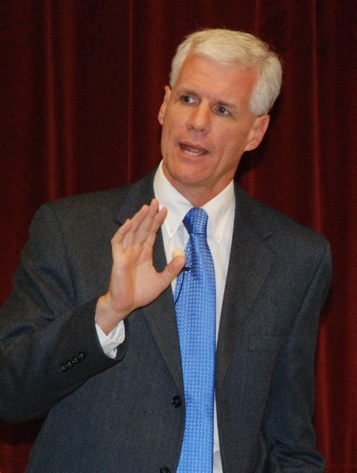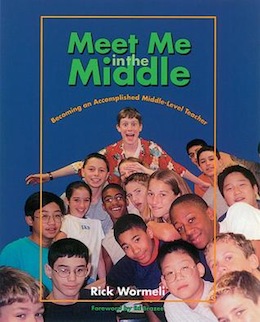Rick Wormeli’s Middle Level Fundamentals
Rick Wormeli is a National Board Certified Teacher, the author of seven respected books in the teaching field, and an internationally known speaker on middle-level education, classroom assessment, innovation, and teacher professionalism. He’s also been an educational consultant to National Public Radio, USA Today, and the Smithsonian Institution. He’s a long-time friend of MiddleWeb. This is a two-part article. Here’s Part 2.
4 Fundamentals of Middle Level Teaching (Part 1)
by Rick Wormeli

It really is. With the transformative work of the Association for Middle Level Education (AMLE), the National Forum to Accelerate Middle-Grades Reform and their Schools to Watch program, the National Association of Secondary School Principals, the Southern Regional Education Board (MMGW), plus new insights and support from myriad researchers and expert practitioners, we have more information on how to teach young adolescents effectively than we’ve ever had before.
When applied effectively in our daily classroom practice, it all works as promised. Best of all, politicians, business leaders, and those outside of middle level teaching are finally recognizing the critical role the middle years play in everyone’s future success, and they are supporting us.
In the midst of all this forward momentum, however, it’s important to float above the treetops and look at the larger landscape, to see what kind of job our colleagues across the profession are doing as middle grades educators.
My outlook? We could be doing better
In my capacity as a teacher trainer, I get to see the big picture of teaching and learning in the middle grades, traveling all over North America and abroad, observing a wide variety of middle level teachers and principals at work.
While most are doing well, some are not. In almost all situations in which schools and teachers could do better, one or more of what I consider four fundamentals of middle level teaching are in their nascent stages — or missing completely. Whatever we can do to help educators develop all four of these fundamentals is time well spent.
Fundamental #1: We must apply what we know about our unique students
Here’s a potentially insightful activity: let’s take out our lesson plans and circle those places where our expertise around the nature of 10 to 15 year-olds is clearly demonstrated. Do we end up with lots of circles?
This is not a group of slightly more complex primary students. Nor is it a group of immature high schoolers. These kids are unique. We can’t, for example, just assign a lengthier version of expository writing than students were asked to do in the early elementary grades and think we’re being developmentally appropriate for middle level students.
When I ask middle level teachers to show me how their lessons respond to the unique nature of young adolescent students, sometimes I get a blank stare. That scares the heck out of me. I begin to think these folks are teaching blind to the students they serve, and that can’t be good. There is a way to teach high school seniors that doesn’t work with middle school students — just as we can’t take what we know about 12 year-olds and think it works the same way with 17 or 18-year old teens. It all comes down to what we know about human growth and development.
So what is it about young adolescents that we should take into consideration when designing and implementing our lessons? Here’s a small taste:
They can’t all be lumped into the same readiness levels – emotionally, intellectually, hormonally, or physically. Girls mature faster than boys. Bones grow faster than muscles, so coordination isn’t consistent. There is discomfort in the growth plates on the ends of their bones that requires frequent movement to relieve, even in mid-lesson. With growth comes the need to eat – about every 90 minutes. They worry intensely over body changes, and they have an increased need for hydration. In her book Brain Matters (2010), Pat Wolfe reminds us that they have an increased tendency toward addictive behaviors and pleasure seeking.

They are fiercely independent, yet paradoxically, they crave social connection. This is the first point in their lives that they realize how wrong adults can be, and they’re not sure what to make of it. They move from concrete to abstract thinking, sounding like adults when talking about some topics, and young children when discussing others.
They crave competence, self-definition, creativity, vividness in learning, emotionally safe environments, control/power over their lives, physical activity, positive social interactions with adults and peers, structure and clear limits, and meaningful participation in school/community. Most of all, they want to belong.
Middle level teachers should be able to cite these attributes and many others without hesitation, and their lessons should reflect this expertise.
Where in our lessons have we provided concept vividness? Where have we helped students move from concrete to abstract? Where have we given students some decision-making power in their learning?
Great resources for getting up to speed on what is currently known about young adolescents include several excellent AMLE publications: Middle School Journal, Middle Ground, and Research in Middle Level Education Online. I also recommend An International Look at Educating Young Adolescents (Mertens, Anfara, Jr., Roney), Turning Points 2000, This We Believe (AMLE), and the pioneering work of Chris Stevenson, who wrote Teaching 10 to 14 Year-olds.
Fundamental #2: To become proficient, we have to fail a lot

Gaining proficiency requires us to spend a fair amount of time failing. In every career considered a profession, the professional model works very well: We learn knowledge, we apply that knowledge in specific situations in our jobs, we get critiqued on how we’re doing, and we revise our knowledge and efforts in light of that critique. When we continue going through this cycle again and again, we mature in our field and are more effective as a result. It’s the stuff of teaching hospitals, professional development schools, architectural schools, CPA offices, police and fire department academies, law firms, journalism – every profession.
Effective middle grades teachers offer this same powerful cycle of learning to our students. And we do it with the understanding that we are guiding the intellectual development of insecure, morphing humans in transition.
Ineffective middle grades teachers, on the other hand, rely on antiquated teaching algorithms like: Read Chapter 12; answer 1-23 on p. 317; take notes on two lectures; watch one 35-minute video; practice with flash cards; take the test on Friday. From this sequence, they expect students to absorb and retain information in long-term memory. While any one of these actions may help students learn something in the short term, none of them are the best recipe for long-term mastery, which is the school’s goal or certainly should be.
If we want our students to achieve mastery of standards with any kind of consistency, we have to revisit content and skills repeatedly throughout the year, and in different contexts and from different angles. Learning is recursive. We don’t dare assume students learn something because we said something, and we don’t declare students lazy when they fail to learn. Instead, we create constructive responses to failure.

But this procedure is simply knowledge conveyance. There’s nothing here about moving things into long-term memory through recursive practices, circling back over and over again with new approaches to the same content.
In my example, new units of study should incorporate this information about noble gases. We can require students to use this data in analyzing the effects of noble gases in new situations and inventions – ask them to draw comparisons between noble gases and characters in a novel – ask them to explain the Periodic Table’s taxonomy when discussing nomenclature and classification. We can also assign students to explain repeatedly, in a variety of formats, why a narrow temperature range between melting and boiling points matters, and which elements are found most commonly in the universe and which ones are most rare.
If we are effective “recursive educators,” we visit and re-visit the content/skills that provide the most leverage in our students’ education, assessing students each time, providing feedback, and engaging them in re-learning as necessary, however long and whatever method it takes. This means we allow students to re-do work and assessments over and over until they hit the high standard set for them, and we give them full credit for mastery when it is finally presented, not partial credit because they didn’t learn it on our prescribed timetable.
If we are effective, we build our previous curriculum targets into subsequent assessments to see what students carry forward, which is the true testimonial for a grade (our grade as well as theirs). If the evidence offered does not reflect the high level presented during the original unit, then the grade for that standard, for that student, goes down until clear and consistent evidence of higher mastery is presented.
If we are effective, we focus these extended efforts primarily on the non-negotiable “Power standards” we have to teach — and we have to focus on those because there is not enough time during the school year to give this much effort to all the standards listed in our curriculum. We incorporate our colleagues’ course content in our own classes, and they use our course content in their classes, so that we all reinforce each other’s important learning.
NEXT TIME: To make all this work, we have to get very specific and very frequent with our feedback to students.
In my second post, I’ll talk about Fundamental #3: We Need a Heck of a Lot More Descriptive Feedback. And I’ll wrap up the final pair of fundamentals with #4: You Know a Heck of a Lot More Than Your Pacing Guide.



































Rick’s Fundamentals will be a valuable resource for my online mentoring with new science teachers this school year!